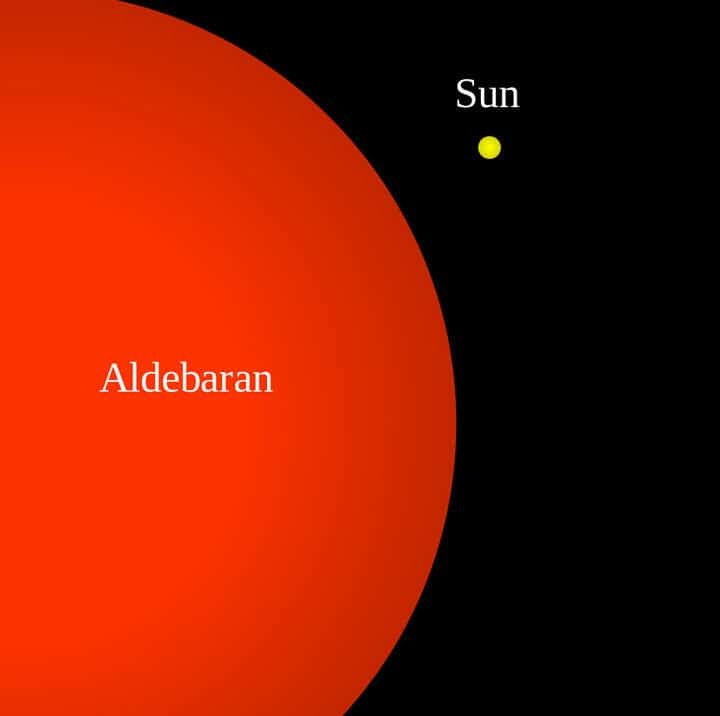Aldebaran is a celestial body that is often referred to as the “eye of the bull” in the constellation Taurus. It is one of the brightest stars in the night sky and is easily visible to the naked eye. Aldebaran is classified as a red giant, meaning it has reached the later stages of its stellar evolution. It has a diameter about 44 times that of the Sun and is estimated to be around 65 light-years away from Earth. Aldebaran is also known for its close proximity to the Pleiades star cluster, which adds to its visual appeal in the night sky.
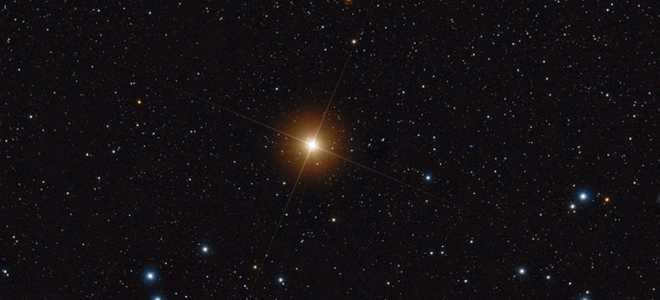
For over 3000 years, the star Aldebaran has been a prominent feature in the night sky, capturing the attention of humans. It is mentioned in fantasy literature and has made appearances in films, making it a popular subject among astronomy enthusiasts.
General information
Indeed, Aldebaran has an age of billions of years. Throughout this extensive timeframe, the formerly red planet has undergone a transformation in its spectral hue and now possesses an orange color, classifying it as a K5III star. This star is considered a normal giant and displays minimal light amplitude, indicating its relative stability.
Over the course of many centuries, Aldebaran has depleted all of its hydrogen reserves in its core and has subsequently transitioned to consuming helium.
These processes have resulted in an expansion of the star’s size and an increase in temperature, altering its appearance. According to the most recent data, the primary component of the star’s envelope has expanded to a diameter equivalent to 38 times that of the sun.
Given a few more eras, the helium in the star’s atmosphere will deplete, causing Aldebaran to transform into a white dwarf.
At present, Aldebaran is a supergiant star that has a size 44 times greater than the Sun.
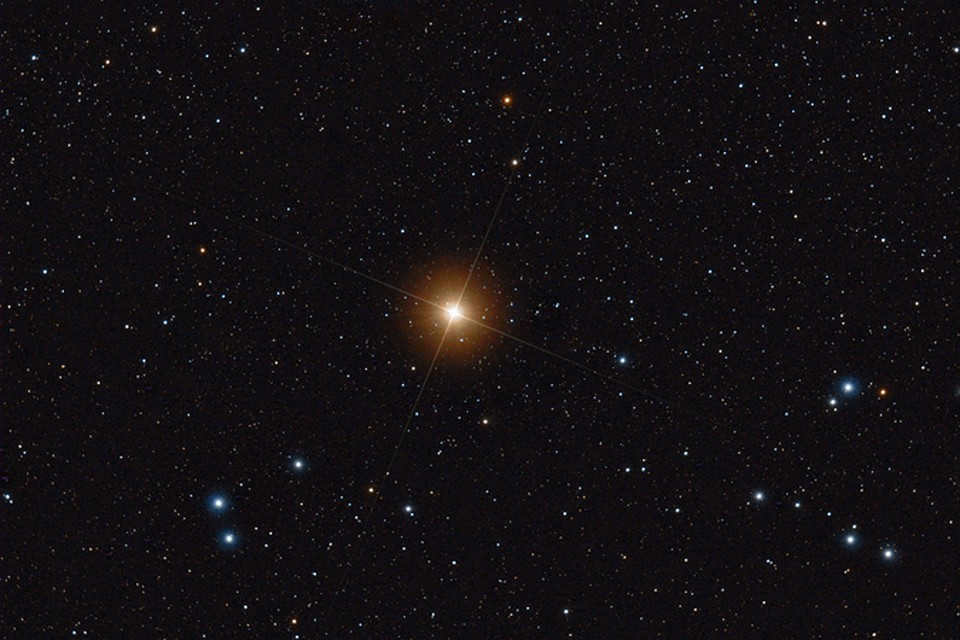
The planet’s visibility is determined by its relatively close proximity to Earth – just 65 light years away.
When observing the stars, it may appear that Aldebaran is a part of the Hyades group, forming a shape similar to the letter “V”. According to astrological records, this star is considered to be a part of the Taurus constellation, symbolizing its eye.
However, this is actually an illusion. While the stars of the Hyades cluster are gravitationally attracted to each other, Aldebaran is a loner, appearing to be projected onto the cluster. The closest neighbors to the star are located 20 light years away.
This visual deception is supported by cosmic distances. Aldebaran is approximately twice as close to the Sun compared to the Hyades. The star cluster itself is situated around 135 light years from Earth.
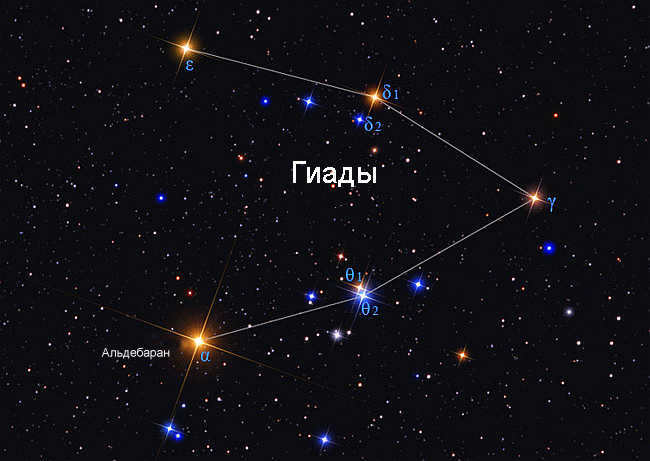
Origin of the name

The star Aldebaran is mentioned in ancient treatises of various peoples, giving it multiple names. The Greeks referred to it as “Lamparus”, meaning “lighthouse” or “torch”, which accurately describes its brightness in a dark sky, thanks to Claudius Ptolemy.
The Romans, on the other hand, commonly called this star “Palilicium” in honor of the equinox holiday of Pales. The Persians referred to it as the “Royal Star” or “Tusketeer”, while the ancient Chinese called it the “Heart of the Bull”.
Due to its position in the constellation, Aldebaran is also known as the “Eye of the Wolf”. In the East, it is sometimes referred to as the “God’s Eye” or the “Buddha’s Star”.
In Bulgarian folklore, Aldebaran is not associated with Taurus, but rather with the Hyades. The Bulgarian people gave the nickname “The Bagpiper” to the bright planet and referred to the star cluster as “The Round Dance”.
The origin of the name, which is recognized as the official name by scientists, can be traced back to Arabic roots. In translation, it means “follower”, as it is seen following the Pleiades. The Pleiades are a large scattered cluster in the sky, with only 7 stars visible to the naked eye.
In the early 17th century, Aldebaran was designated with a letter, becoming known as “Alpha Taurus”. This name was given by Johann Bayer, a German astronomer, in his renowned work “Uranometria”.
Characteristics of the star’s physical appearance
By examining the star’s physical features, scientists are able to classify and categorize it. The orange giant, classified as K5 III based on its spectral class, is positioned in scientific registries. The table below provides the key parameters of the star.
Physical attributes of α Taurus
| Parameters | Unit. | Indicator (average) |
| Mass of the celestial body | M☉* | 2.5 |
| Size | R☉ | 43 |
| Age | billion years | 6.6±2.4 |
| Metal content** | % | 70 |
| Temperature | K | 3875±3050 |
| Brightness | L☉ | 150 |
*This is a non-standard unit of measurement used to estimate the characteristics of stars in relation to the Sun (M, R, L)
Parallax is a crucial factor considered in astrometry. It calculates the angle of displacement of an object in relation to the observer’s position. In the case of Aldebaran, this value is measured at 50.09 mas (milliseconds), enabling precise determination of the star’s distance. Additionally, the planet’s radial velocity falls within the range of 53.8 km/s.
Positioning in the sky
In the period from November to January, the zodiacal constellation reaches its highest point above the horizon. During this time, the distinct shape of Taurus becomes clearly visible, but what really catches the eye is the intense red eye of the “furious” Bull, known as Aldebaran. The animal’s horns are formed by fainter stars.
The famous star cluster, Hyades, creates the outline of the “head” and the crow’s eye seamlessly fits into it. And sitting on the back of Taurus, we can see the beautiful star cluster called Pleiades.
To locate Pallium in the sky, it is helpful to know which constellation it belongs to. One can begin the search by looking for familiar landmarks in the evening sky, such as the Bucket of the Big Dipper. This constellation is part of the non-setting group, making it an excellent starting point for the search ahead;
The position of the Bucket varies depending on the time of year. In winter, it can be seen in the northeast, while in the fall and summer, it is located in the north. Once the outermost stars of the Bucket are found, they can be connected by a straight line.
Continuing the line upwards will lead to the first bright star, known as Polaris. This is how the Little Bear constellation is identified. The second constellation is useful for easier navigation of the cardinal directions. Polaris, along with its small dipper, can be found north of the Big Dipper.
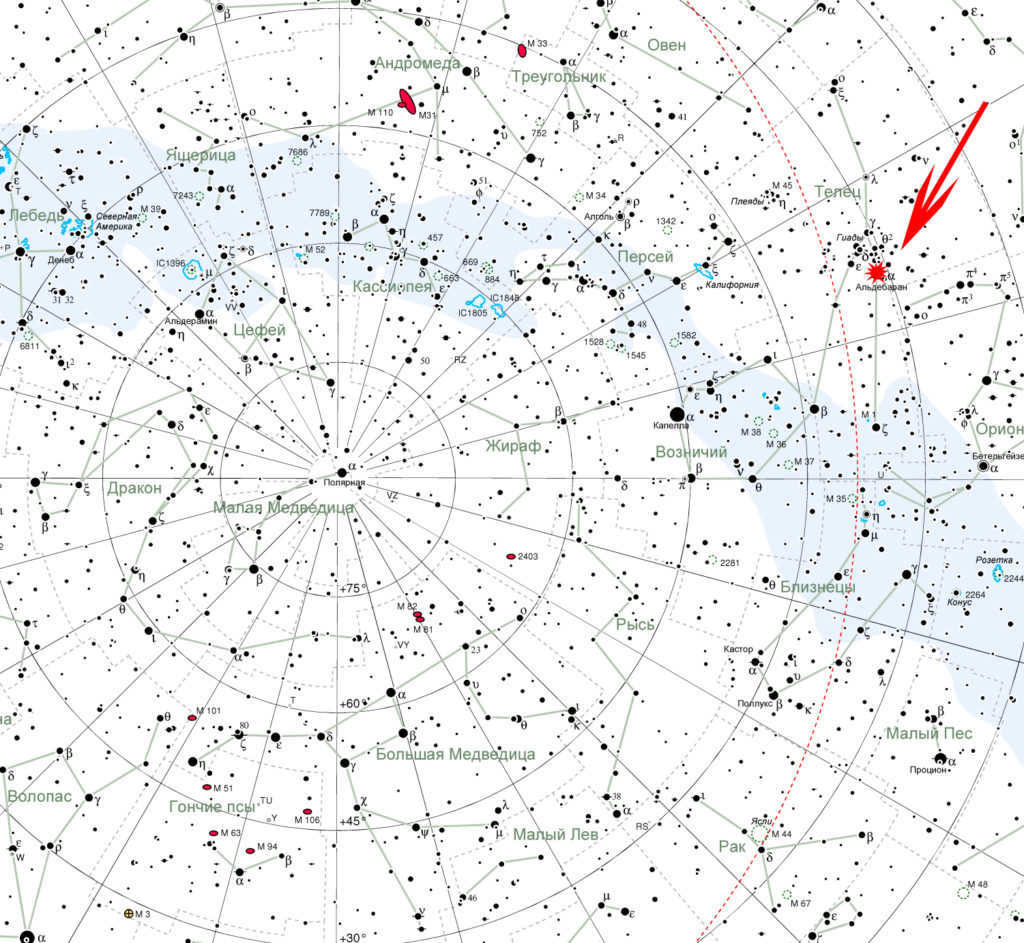
In the autumn-winter period, when the Taurus constellation is prominently visible in the sky of the Northern Hemisphere, you can proceed with the search for Aldebaran. The following steps can be taken:
- Locate the Big Dipper in the winter sky around 20 hours and take note of the 4 corner points of the dipper.
- Mentally draw a straight line to the east from the lower right star of the dipper, Merak.
- Continue past Gemini until you reach the brightest star, Betelgeuse.
- Here you will find a group of planets forming Orion. The figure of the “hunter” is made up of 7 symmetrically arranged stars, which are clearly visible in the night sky.
- Further north, in a direct line (and to the southeast of Polaris), you can spot the shape of the letter V; this is where the star Aldebaran is situated, marking the southern eye of the Bull.
Another significant feature is the Pleiades, which are sometimes mistaken for the Little Bear’s Bucket. It is located just above the Taurus constellation. To enhance your search for the planet, it would be helpful to have a visual representation of the night sky. When determining the position of the star Aldebaran, a map should also be utilized.
In your search, you can also rely on other constellations such as Ascendant, Perseus, Eridanus, Aries, and Gemini. Taurus is surrounded by these constellations.
The precise position of Alpha Bull is calculated to be at 04 h 35 m 55.2 s; with a declination of +16°30´33″. However, these coordinates are better understood by experts. In the evening, it is evident how Orion’s Belt and Aldebaran rise almost simultaneously in the eastern sky.
Emerging in the winter sky shortly after sunset, the star shines brightly throughout the night. By March, Alpha Taurus has already reached its highest position and after midnight, it sinks below the horizon.
In the first few days of May, the planet briefly becomes visible, but by the end of the month, it becomes nearly impossible to spot in the sky. It only reappears in the early hours of the morning by mid-summer.
Thus, it is more advantageous to observe the celestial body during the winter period. However, it must be noted that in the month of December, Jupiter emerges in the Taurus constellation, shining significantly brighter than the “Eye of the Beholder”. This causes Aldebaran to appear dimmer in comparison, leading to confusion among observers.
Occasionally, it is possible to witness the Moon obscuring the “God’s eye”. The most recent occurrence of this phenomenon in the daytime sky was in August of 2017.
Curious Trivia
Scientists have been captivated by the dazzling star for quite some time. In the 1970s, the Pioneer-10 spacecraft was sent on a mission to Aldebaran, and to this day it has not ventured beyond our solar system. It still has a staggering 2 million light-years to travel before reaching its ultimate destination.

In anticipation that an advanced civilization may exist on Alpha Taurus by that time, scientists have equipped the “messenger” with information regarding the solar galaxy, the Earth’s structure, and the various forms of life present on it.
Since 1989, the state satellite Hipparchus has been operating in space for over 3 years. Through its research, the distance between Aldebaran and the Sun has been more precisely determined. It has also been discovered that both planets align into a single visible point once a year (which occurs on June 1).
Ancient treatises also mention intriguing facts about Alpha Taurus:
- Several millennia ago in Babylon, the rising of this star served as a signal for the beginning of the year, aligning with the vernal equinox;
- The Pleiades were highly respected by the ancient Mexicans, who referred to them as “birthing women” and believed that the bright star illuminated their path.
- The Dakota tribe has a story about Aldebaran descending to earth, killing a snake, and from its blood the Mississippi River was created.
The ancient Greeks associated Zeus with the Bull (Taurus). It was in this form that the Olympian God conquered Europe, captivating it with his gaze. Therefore, in the myths, Aldebaran, the Bull’s Eye, is attributed with magical powers.
Aldebaran is mentioned in various fantasy works by authors such as Lee Brackett, Joe Haldeman, Kim Robinson, James Joyce, and George Orwell. It also appears in Tolkien’s Lord of the Rings and the comic books of Eduardo de Oliveira.
In the writings of the ancient Arabian author Fizuli, the planet is frequently referred to as Dəbəran. Many of Kir Bulychev’s novels are set on Alpha Taurus.
Star and its significance in astrology
Astrologers find it significant that the star Aldebaran is located in the zodiacal belt. Its influence on earthly processes is comparable to that of Jupiter. It is also worth noting its combined influence with Mars and Mercury.
During the period when the Sun is in conjunction with Alpha Taurus (which occurs in late May – early June), individuals with creative talents such as actors, writers, and politicians are born. The influence of this celestial “tandem” has been felt by various notable individuals, including the Russian poetess E. Marx, the French revolutionary Louise Michel, artists Yanina Zheymo and Marilyn Monroe, actors Alexander Abdulov and Clint Eastwood, musician Vladimir Kuzmin, and the prominent American figure John F. Kennedy.
In ancient Roman astrology, there were four fixed stars known as the Guardians of the Sky. Aldebaran guards the eastern gate, Antares guards the west, Regulus guards the north, and Fomalgaute guards the south.
In terms of the spiritual Horoscope, these fixed stars serve as angular points that determine the paths of development in both space and time.
Meteorological Impact of Alpha Taurus
Meteorologists have noted that the presence of Alpha Taurus has a significant influence on the planet’s climate. When Aldebaran aligns with the rising Sun, it is an indication of foggy, windy conditions accompanied by rainfall and thunderstorms.
Furthermore, when Alpha Taurus coincides with the appearance of Mars, it exacerbates natural disturbances, leading to the formation of hurricanes and intense heat during the summer months.
Satellites of Aldebaran
Astronomers have discovered that Aldebaran, a red dwarf belonging to the M2 class, has a satellite. Using special techniques, they determined that its apparent magnitude is 13.6 and its absolute magnitude is 11.98. The satellite is located at a distance of 607 astronomical units from Alpha Taurus.
This discovery suggests that Aldebaran and its satellite are not just optical companions, but part of a binary star system. They are similar to objects C and D, which are gravitationally bound. However, Aldebaran and its satellite only interact visually and are located outside the planet in the Hyades cluster.
In addition, scientists proposed in 1993 that there may be a large planet with a mass of 11 Jupiter in the orbit of the “Eagle Eye” at a distance of 1.35 astronomical units from Jupiter.
In 2015, astronomers made a discovery about the main component of Aldebaran, known as Aldebaran Ab. They found that it has a hot giant planet orbiting around it, which is estimated to be 6.47 times the mass of Jupiter. This exoplanet completes one orbit around Aldebaran Ab in approximately 629 days.
A comparison of the luminosities of different stars
When Alpha Taurus started burning helium, it expanded in size, resulting in an increase in its brightness. This made it one of the most visible stars from Earth. In terms of apparent luminosity, it ranks 14th in the northern sky hemisphere. Aldebaran has an absolute stellar magnitude of only 150 Suns, making it the second brightest star after Alpha Scorpius. Antares, on the other hand, surpasses the Sun’s luminosity by 4,000 times.
There are also other brighter objects in the Orion’s belt. Betelgeuse (α) has a luminosity that is 80,000 times that of the Sun, while Rigel (β) has a luminosity of 45,000 times that of the Sun. However, the largest star is the Goldfish in the Magellanic Cloud, with an absolute luminosity that exceeds the solar luminosity by 600,000 times.
When observing celestial objects from our planet, we utilize the concept of “apparent magnitude”, which differs from absolute magnitude in that it takes into account the distance between us and the object being observed. In fact, even Hipparchus, the ancient Greek astronomer, used the luminosity of Vega (α Lyrae) as a benchmark for his estimations, assigning it a stellar magnitude of 0m. However, Vega is not the brightest object in the sky, and therefore, objects with a higher brightness are assigned a negative value for this parameter.
If we were to rank stars based on their apparent magnitude, the most luminous objects would look as follows:
The most brilliant celestial bodies
| Name | Alpha constellation | Distance from the Sun, in light years | Mass compared to the Sun | Stellar brightness |
| Arcturus | Boötes | 36.7 | nearly the same | -0.05 |
| Vega | Lyra | more than 25.3 | 2.1 | 0.03 |
| Procyon | Canis Minor | 11.5 | 1.4 | 0.38 |
| Betelgeuse | Orion | 495-640 | 13-17 | 0.5-1.2 |
| Altair | Aquila | 18 | 1.79 | 0.77 |
| Aldebaran | Taurus | 65 | 2.5 | 0.85 |
| Deneb | Cygnus | 1550 | 15-25 | 1.25 |
| Regulus | Leo | 77.5 | 3.5 | 1.35 |
Based on the data provided in the table, Swan’s α can be considered the most dominant star. Deneb, despite being significantly distant from the Solar System, is not much less powerful than Aldebaran in terms of its apparent stellar magnitude.
When compared within the Zodiacal Belt, Alpha Taurus shines the brightest. Antares (α Scorpius) follows closely with a magnitude of 1.09, and Pollux (Gemini) with a magnitude of 1.15.
Aldebaran stands out as one of the most brilliant celestial objects, visible to the naked eye at night. This is attributed not only to its brightness, but also to its location in outer space in relation to the prominent Hyades cluster.
For representatives of ancient civilizations, this star held great significance. For instance, it was utilized to mark the beginning of the new year in Babylon. However, equally intriguing is its positioning in the birth chart, which we will discuss below.
Essential details about the star Aldebaran
The night sky is filled with countless stars, but for over three thousand years, one particular star – Aldebaran – has captured considerable attention. This celestial object is frequently featured in science fiction literature and movies. Astronomers are captivated by everything related to Aldebaran, while astrologers meticulously examine the birth chart of individuals in which this bright star is present.

We have compiled a collection of valuable resources that can assist you in transforming various aspects of your life, including relationships, finances, career, health, and purpose.
These resources consist of tried and tested methods that have yielded positive results for 98% of our students.
Typically, these documents are exclusively available to our students. However, for a limited time, we are offering them for free. Please note that access to these resources will be restricted soon.
- Checklist: “Where to Begin Learning Astrology” – Learn how to develop a comprehensive and effective approach to your studies
- Birth Charts and Planetary Overview – Gain insight into the characteristics of each planet and their impact on individuals
- Guide: “Zodiac Signs” – Explore the classification, associations, and unique qualities of each sign
- Guide: “Houses” – Discover the significance of different events and areas of life represented by each house
- Step-by-step guide “House Ruler”: Exploring the Influence of the Ruler on the House Sphere
- Hyde’s “Major Aspects”: Unraveling the Energetic Connection Between Planetary and Cuspidal Chart Readings
- Synthesis of the Classical Napoleonic Quardatura: Shedding Light on an Exemplary Case
- Development Plan Guide: Unlocking the Blueprint for Optimal Life Trajectory
All the hydrogen on the planet has been completely burned off, leaving helium as the next element in line. This transformative process has caused the planet to expand in size, subsequently raising the temperature of the star Aldebaran. According to the latest data, the main component of the shell has expanded to nearly 40 times the diameter of our sun.
In a matter of centuries, the helium within the atmosphere will deplete, leading the planet to transition into a white dwarf.
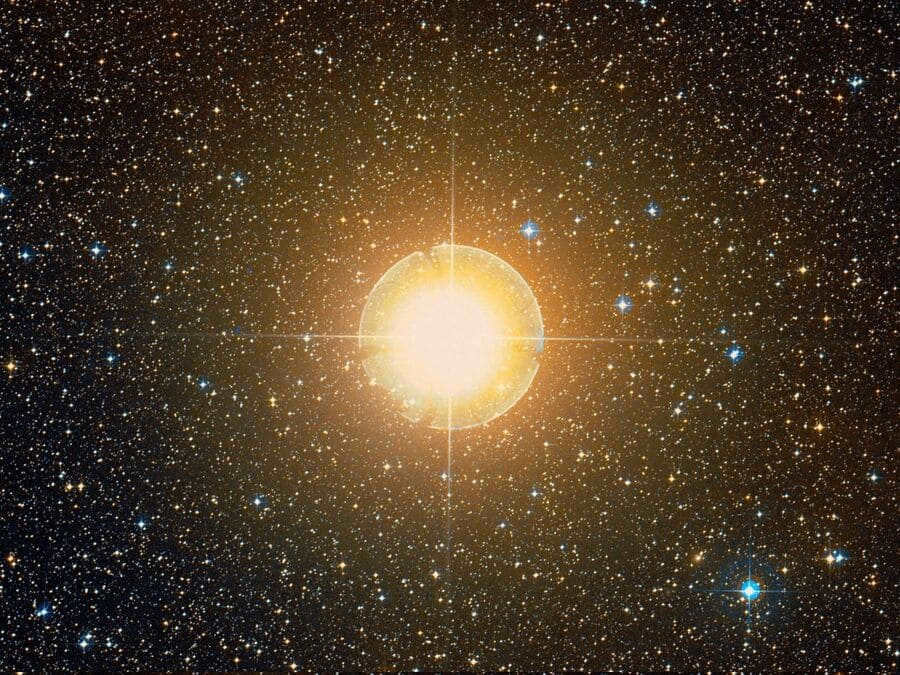
Because it is located just 65 light years away from Earth, Aldebaran can be easily seen in the night sky. Aldebaran is a part of the Taurus constellation. However, observers on Earth often mistake it as a member of the Hyades group, which, along with four other stars, forms the shape of the letter “V”. Unlike other stars in this group, which are connected by gravitational forces, Aldebaran is considered a “loner”.
Its closest neighboring stars are located about 20 light-years away. This visual deception is also supported by the actual distances in space. Aldebaran is twice as close to the Sun compared to the Hyades, and the distance between Earth and the star cluster is approximately 135 light years.
Interpretation of the Name Aldebaran
The designation of the immense celestial body Aldebaran originates from an Arabic term denoting a series or order. This appellation was assigned to the star because, during ancient eras, it appeared to trail behind the Pleiades cluster when gazing at the celestial expanse. Notwithstanding its long-standing title, the International Astronomical Union officially recognized the star’s nomenclature in 2016.

Are you interested in gaining an understanding of astrology and how it can be beneficial in your everyday life?
- Do you want to acquire the fundamentals of astrology?
- Gain insight into your strengths and weaknesses?
- Are you ready to learn the most modern and effective methods of studying astrology?
- Are you intrigued by the skill of interpreting birth charts?
- Learn how to construct a natal chart.
- Recognize the significance of planets and zodiac signs.
- Understand the secrets to financial success.
- Receive a step-by-step guide to developing your skills in astrology.
Aldebaran is also known by other names:
- Royal Star.
- Palilicium.
- Palilia.
- Aldebaran.
- Oculus Taurī.
The star Aldebaran was believed by the ancient Persians to possess unique qualities as it was considered to be a guardian of the heavens and a member of the royal stars.
Characteristics of the star
Below is a summary of the physical properties of Aldebaran, including its mass, type, temperature, size, and more.
The star’s description provides valuable information for scientific databases. Based on its spectral class, Aldebaran is classified as an orange giant and falls under the designation K5 III. The main parameters of the planet are listed in the table:
Parallax is a measurement used in astronomy to determine the angle at which an object’s position appears to change when observed from different locations. In the case of Aldebaran, this measurement is equal to 50.09 mas (milliseconds of arc). This value allows for the most precise calculation of the distance to this celestial object. Additionally, the radial velocity of the star fluctuates within a range of 53.8 km/s.
We have previously provided information about the specific stellar alignment in which the star Aldebaran can be found. This particular constellation reaches its highest point above the horizon between the months of November and January. During this time, the constellation Taurus is easily seen in the night sky, with the most prominent feature being the blood-red eye of the Bull, which is none other than Aldebaran. The horns of Taurus consist of stars that emit a slightly less brilliant radiance. The cluster of stars known as the Hyades forms the outline of the head, while the Pleiades can be found on the back of the celestial Bull.
If you are familiar with the constellation Pallium, locating it in the starry sky should not pose a challenge. Begin by identifying the constellation of the Big Dipper, which is a circumpolar constellation that never sets below the horizon. This makes it an excellent starting point for further celestial observations. The only variation is that during the winter months, the Big Dipper is visible in the northeastern part of the sky, while in the summer months, it can be found in the northern region.
Once you have located the outermost stars of the Big Dipper, connect them with a straight line. By continuing in the direction of this vector, you will eventually come across Polaris, which can be used to determine the position of the Little Dipper. This will provide a more accurate indication of the northern direction. The Little Dipper is situated to the north of the Big Dipper.
To spot the Taurus constellation, it is only visible in the fall-winter period when it can be seen in the Northern Hemisphere. To do so, follow these steps:
- At around 8 PM, look up at the winter sky and locate the Big Dipper. Take note of the four corners of the dipper.
- Mentally draw a straight line to the east from the lower right star.
- Continue along this line, passing through the Gemini constellation, until you reach Betelgeuse, the brightest star.
- The constellation of Orion consists of seven stars arranged symmetrically.
- If you look north in a straight line and southeast of Polaris, you will see the shape of the letter “V”. Aldebaran, a bright and reddish star, is located at the southern eye of Taurus.
Furthermore, if you are searching for Aldebaran, you can also look for the Pleiades, which are sometimes confused with the Little Dipper. They are situated just below the Taurus constellation. Having a star map will make the search for a planet more efficient.

Additional points of reference include the constellations of Ascendant, Perseus, Aries, and Gemini. However, locating the star Bull in these surroundings can be somewhat challenging.
The optimum time to observe the star Aldebaran is during the winter season. In the month of December, Jupiter traverses through the Taurus constellation. The planet appears significantly brighter and larger, causing the star to appear less prominent in comparison.
The significance of Aldebaran in astrology
Aldebaran, the left eye of the Bull in astrology, is associated with wealth and prosperity. While the right eye remains unseen from Earth, it represents the spiritual aspect of an individual. This celestial body is linked to the manifestation of desires, the attainment of goals, and the acquisition of one’s desires. Furthermore, Aldebaran possesses the energy of Mars, as the planet is characterized by its red hue. The combination of Aldebaran with other stars plays a pivotal role in shaping the destiny of the individual.
Individuals influenced by this star possess a potent energy that exudes charm, magnetism, and allure. They effortlessly form connections and draw people towards them. Moreover, this star endows them with determination and confidence, enabling them to successfully achieve their ambitions.
However, alongside these positive traits, there are also negative aspects associated with this star. These include stubbornness, selfishness, and an inclination to indulge solely in their own desires. As the eye of the Bull-Zeus (also known as the Eye of God), individuals with the Aldebaran star in their natal chart may also exhibit clairvoyant abilities and a propensity for making predictions.
Aldebaran and its Alignment with the Planets
The Sun
Individuals born under the Aldebaran alignment are known for their high energy, determination, strength, and resilience. They often take up leadership roles and excel as managers, although they may also face opposition from others. The path to fame and recognition for these individuals can come at a great cost. The conjunction of Aldebaran with the Sun signifies a life of extremes. It can bring unimaginable material rewards, but it also carries the risk of losing everything, damaging one’s reputation, facing disgrace, experiencing sudden downfall, or even encountering life-threatening situations. Additionally, when both the Sun and Mars are in conjunction with Aldebaran, there is a higher likelihood of contracting infectious inflammatory diseases.
Moon
There is a chance to establish a thriving profession, although it will be challenging, involving the conquering of numerous obstacles. While achieving success in business matters and making notable strides in social endeavors, there is a considerable likelihood of encountering misfortunes such as accidents, acts of violence, fatalities, or illnesses.

When Mars and Saturn align with Antares simultaneously, there is a potential for a person to meet a tragic end. This could be due to fatal injuries caused by sharp objects such as a sword or knife. It is impossible to dismiss the possibility of execution. If the Royal Star aligns with the Sun or Moon on the Zenith or ascendant, one’s path to success may be paved with sacrifice, violence, and adversity.
Mercury
The native is an exceptional leader and a well-known figure. Challenges in family and love life may arise. However, the influence of the star Aldebaran may have a negative impact on health and home. On the other hand, endeavors that fall under the “guardianship” of Mercury tend to be prosperous. The individual is surrounded by abundance and intellectually stimulating individuals.
Achievement in the arts, particularly in writing, music, and other creative pursuits, is a hallmark of this individual. They possess a knack for thinking outside the box and engaging in unconventional love relationships. As a result of their unique mindset, they are able to attain a prominent position within society. In addition, their health is excellent, and they come from a strong and close-knit family.
Mars
Success in the military carries with it inherent danger and risk. However, this individual excels in commanding and navigating challenging situations, earning them the respect of others. They may encounter difficulties within their family and face legal issues. Additionally, they may be prone to complicated illnesses and a violent death cannot be ruled out. If the Moon is in conjunction with Antares, the likelihood of death from impact, falling, or cold weapons is significantly increased.
Jupiter
The native is known for their leadership qualities and is likely to hold a high social position. This could include roles in religious or military ranks.
Saturn
There is a significant likelihood of experiencing losses related to water, such as tsunamis, floods, or other water-related disasters. The individual possesses complex thinking abilities, thinks outside the box, has an excellent memory, and is eloquent in their speech. The native has a sarcastic and inquisitive nature and tends to be reserved. It is important to note that when the Moon is conjunct Antares at a certain time, there is a possibility of death.
Uranus
The person born under the influence of Uranus is known for their inclination towards scientific pursuits. They are highly efficient, energetic, and fair-minded. They have a deep love for nature and possess a strong and authoritative opinion. It is not uncommon for them to have an interest in the occult and esoteric subjects. However, their life may be marked by the possibility of sudden and unexpected death.
Neptune
Individuals influenced by Neptune have a strong fondness for science, art, occultism, and medicine. They possess an exceptional intellect and are known for their intelligence and creativity. The presence of the star Aldebaran in their astrological chart indicates potential losses due to fire, but also profits from metal and machinery, as well as opportunities for travel. However, they may face challenges in personal and family life, and the situation may not be favorable for having children. Additionally, there is a risk of death from accidents.
It is indicated that the individual possesses an extraordinary amount of energy and a natural inclination towards leadership. The person is highly likely to thrive in positions of leadership and hold high-ranking positions. However, this also increases the likelihood of having numerous enemies. Additionally, these individuals are known for their patience.
The Wheel of Fortune
Symbolizes poverty and indebtedness.
When the Moon aligns with Antares, the likelihood of fatality caused by cold weapons, stab wounds, and accidental falls is significantly increased.
The majority of astrologers correlate the star Aldebaran with adversities, fatalities, disappointments, and obstacles. However, there are dissenting opinions among experts regarding this interpretation. Some argue that danger is only present when the star Antares, also known as the Guardian of the West, is involved. It is considered to have malevolent influences.

Aldebaran has been recognized by humanity since ancient times. In ancient Persia, it was referred to as the majestic or imperial star.
It is interesting to note that Aldebaran is a binary system, consisting of:

- The star Aldebaran is classified as a K5 III giant due to its orange color.
- On the other hand, star B is categorized as an M2 dwarf.
It was discovered that the massive celestial body had completely consumed all of its hydrogen reserves on its surface. As a result, the star began undergoing helium burning and underwent significant expansion. Scientists predict that in a few billion years, Aldebaran will transform into a white dwarf.
The Constellation to Which Aldebaran Belongs
Aldebaran, in actuality, is a part of the Taurus constellation. It holds the title of Alpha in this specific region of the night sky. Furthermore, it stands as one of the most luminous stars within the Zodiac, and some may even argue that it shines brighter than any other star in the entire celestial sphere.
The name Aldebaran is derived from Arabic and translates to “follower.” This likely originates from its position directly trailing the Pleiades cluster.
Additionally, this star is often referred to as the “Eye of Taurus” due to its resemblance to the eyes of a bull. It is also known by other names such as Palilius and Lamparus.

Did you know?
Did you know that the giant star is over 6.5 billion years old? Researchers have discovered that its radius is a whopping 43 times larger than the radius of the Sun. Not only that, but it is also 2.5 times more massive than our very own Sun.

It shines brighter than our star. It is exactly 150 times brighter. Based on astronomical data, Aldebaran is ranked 14th on the list of the brightest stars.
Astronomers have observed that the Moon sometimes passes in front of Aldebaran. Interestingly, this phenomenon can be observed even during daylight.
There is a possibility that a large planet orbits around Aldebaran. However, there is currently no evidence to support this.
Priests pray to stars. Poets sing to stars. Scientists study the paths, brightness, and make significant discoveries about stars.
Vikenty Veresaev. Star
The legend of Aldebaran
In ancient times, the realm of space and the stars held a deep connection with mythology. This particular area of the sky is no exception to that rule.
In Greek mythology, there existed a stunning woman named Europa, who was the daughter of King Agenor. She caught the attention and affection of Zeus, the king of the gods. To win her heart, Zeus transformed himself into a majestic bull. Europa, intrigued by the bull’s allure, climbed onto its back, and together they journeyed across the sea to the enchanting island of Crete. It was on this island that the couple’s love flourished and they gave birth to three sons, forever etching their story into the annals of mythology.


For instance, the hunter Aldebaran was believed by African tribes. Simultaneously, he was the spouse of the Pleiades. As per their folklore, his wives dispatched him to capture a zebra. And instructed him not to come back empty-handed. However, Aldebaran had only one arrow with him. Unfortunately, it missed its mark. Since then, the husband has been pursuing his wives, but is fearful of reuniting with them.
Observing the celestial body
Therefore, we have discovered the location of Aldebaran within a specific constellation. Moreover, this particular constellation happens to be the most brilliant among the zodiacal constellations. It is highly probable that identifying it will not pose any difficulties. Let us now attempt to ascertain the method of locating it in the night sky.
First and foremost, it is important to keep in mind that winter is the optimal season for this endeavor. However, caution is advised. For instance, a more luminous and larger planet traverses through the Taurus constellation during the month of December. Consequently, the star is frequently mistaken for Jupiter.
Secondly, in order to find the constellation, one must initially locate Orion. Subsequently, draw an imaginary straight line extending towards the right. By doing so, it will lead to a radiant point of light. This, indeed, is Aldebaran.
A small number of us have had the opportunity to gaze upon the stars as our predecessors did, for our cities are illuminated far too brightly.
Neil Gaiman. Stardust
There has been previous speculation about the possibility of the luminary having its own planetary companion. In the year 2015, astronomers made an exciting discovery of an exoplanet located at component A. However, the question of whether the luminary truly possesses a planet still remains unanswered. This is due to the lack of conclusive evidence supporting its existence.
Presently, ongoing studies and research are being conducted to further explore this phenomenon. Naturally, scientists are closely monitoring the evolutionary transformations occurring within these celestial bodies.
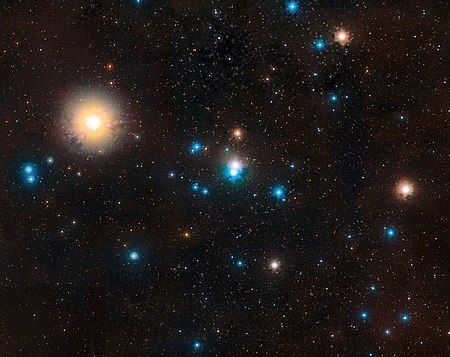
Aldebaran(α Tau / α Taurus / Alpha Taurus) is the most brilliant star in the Taurus constellation and one of the most brilliant stars in the nighttime sky. Its name originates from the Arabic word الدبران (al-dabarān), which means “follower”: the star follows the Pleiades on its journey across the night sky. Due to its position in the head of Taurus, it was referred to as the “Eye of Taurus” (Lat. Oculus Taurī). It is also known as Palilius and Lamparus.
Quotations [ edit ]
Quotes [ edit ]
Notable Sayings [ edit ]
Famous Phrases [ edit ]
Memorable Quotes [ edit ]
Jacob enjoyed the night from his tower, watching as the moon shone brightly and the clouds moved across the sky. He focused his telescope on a particular star, Aldebaran, which belonged to the Taurus constellation. This star held a special significance to him, as he had once admired it with his beloved girl. During that moment, she had expressed a desire for the star to be theirs. Like a Muslim facing the East during prayer, Jacob would always turn his gaze towards this star at the end of each day, hoping that they were both looking at it simultaneously. Years have passed, yet the star still shines in the sky, its flickering light unchanged. The summer nights filled with enchantment have come and gone, but the past cannot be relived. They were young and full of belief in happiness, but she eventually left for St. Petersburg and married someone else. Jacob sighed, wishing her happiness and peace. [1]
The praying men’s proud brows furrowed, and their souls, already embraced by the gentle darkness of death, were clouded by an unnecessary disruption, as an unfamiliar knight emerged at the bend of the ravine. This knight was thin and slender, yet exuded a beautiful strength in his broad shoulders. His visor was lowered, and he wore lats of pure gold that shone as brightly as the gleam of the star Aldebaran.
I was compelled to fulfill the promise made by my ancestors, and thus I traversed the freshly fallen snow that blanketed the path, leading me upwards to the spot where Aldebaran glistened amidst the branches.
Indeed, I witnessed it. Adore, the celestial bodies… I comprehend. Is Zwibol aware of the magnificent appellations of the celestial bodies? Vega, Betelgeuse, Arcturus, Antares, Aldebaran. What brings forth amusement from you? Aldebaran, indeed. I have been yearning for a month to partake in the cinematic experience with you. However, the weather does not favor me. On a summer evening, you prefer the celestial bodies. [2]
Following the directives of the electronic cognition, colossal spacecraft from Deneb, Aldebaran, or the Sun, accompanied by fleets of smaller vessels, were proceeding towards the harbors with remarkable precision.
– I have come up with an idea,” I stated.
– Please share it with me! Just then, a humble grandmother wearing a blue shawl approached us and inquired:
– Would you be willing to deliver a small package to my son in Aldebaran?
– Well,” Poloskov gestured dismissively, “that’s not sufficient!
– It’s a very tiny one,” the grandmother replied.
– Only two hundred grams, nothing more. [3]
It appears that the shrubs are singing. That’s how the shrubs in the Sierra Barracuda Mountains demonstrated their singing abilities and guided the captain towards water, providing a refuge during a severe sandstorm, and ultimately saving the lives of eight astronauts who were afflicted by space fever. To commemorate this extraordinary event, the sculptor included a depiction of a shrub on the monument honoring the Third Captain. Therefore, I suggest exploring the eighth satellite of Aldebaran and searching for these remarkable shrubs in the Sierra Barracuda Mountains. Furthermore, the Third Captain mentioned that the bushes revealed magnificent, luminous flowers in the evening.
– Thank you, Doctor,” I expressed. “We will certainly make an effort to locate these shrubs and bring them back to Earth.
– Can they be grown in pots?” Alice inquired.
– Possibly,” the doctor replied. “However, truth be told, I’ve never seen them before. They are exceedingly rare and can only be found near a spring at the heart of the desert that surrounds the Sierra Barracuda Mountains.
… The Aldebaran system was nearby, so we resolved to seek out these shrubs and, if possible, listen to their melodious singing. Our spacecraft made a total of eighteen orbits around the entire desert, and it was only on the nineteenth approach that we spotted a lush green oasis nestled within a deep hollow. The reconnaissance craft descended over the sand dunes, and the shrubs encircling the spring came into view. These shrubs were relatively short, reaching up to my waist, boasting long, silver-hued leaves and sturdy, compact roots that effortlessly emerged from the sand. We meticulously uprooted five shrubs, specifically selecting those that bore buds, and carefully placed them in a large box filled with sand. We then transported our precious findings back to the Pegasus. That very same day, the Pegasus departed from the desert satellite and embarked on its onward journey. [3]
Cardoman: When did you start feeling like you were a being from another planet?
Papazian: Not long after I was born on Aldebaran.
Cardoman: It would be more efficient if you acknowledged that you have some unusual beliefs.
Papazian: We would save just as much time if you admitted that I am an Aldebaran facing challenges.
Once upon a time, he was captivated by Rostand’s translation in Shchepkina-Kupernik’s version to the extent that he even started composing a piece in rhymed six-stop iambs titled “The Court of the King of Poets,” clearly mimicking Cyrano de Bergerac. I believe that the crux of his work was derived from his favorite line: “Now he serves as a lamplighter at Molière’s theater.” I recall verses from his poem “Aldebaran”: “… behold, in the dark realms, amidst the celestial bodies, in the midnight twilight, a star glides. Its Aldebaran is known as Aldebaran by those who dwell on this earth…” He uttered the word “Aldebaran” with sheer delight. Presumably, the entire poem was crafted for the sake of this single word. [4]
He found himself in a pitch-black, enclosed space. However, his instinct told him that there was another presence within this space. He reached out into the darkness and felt the soft texture of hair beneath his fingertips.
– It’s me, Alexander,” he whispered, “I stumbled upon… Is it truly you, Violina of Aldebaran?
– Oh! Alexander, the offspring of Earth! – the sorrowful Aldebaran responded weakly. – Now we are bound together until death. My spouse trapped us within this confined space, and we have become everlasting companions of this dreadful planet…
– My love! – Alexander exclaimed, his strength restored. – My love! The most crucial thing is that we love each other. And we shall not perish. Earth will not forsake us! Can you hear that? Protests are erupting across the planet. Every ordinary individual on Earth is demanding our immediate liberation. Can you hear, you ignorant Aldebarans! I, Alexander, the son of Earth, do not fear you! In fact, I hold you in contempt. Hey, you, Yemuge. Plump little Aldebaran. Viola loves me! We shall soon have a child, and I shall name him Sanja.
– No, no, no,” Violina sobbed. – There is no salvation for us now. We are doomed. [5]
In the realm of poetry.
The midnight sky adorned with countless stars
The sleepless twinkle of celestial bodies;
Its splendid crown adorned with the Pleiades,
Aldebaran ablaze. [6]
Resembling a circle of radiant
Diamonds, Cancer itches,
And above the azure celestial arch
It permeates the darkness with stars.
And nearby lies a brilliant constellation,
And within it, Aldebaran burns.
As a symbol of sought-after retribution,
It remains steadfast and scarlet. [7]
Aldebaran glistens in the heights,
The ruby, aflame with fervent crimson.
Beckoning me to soar towards it with a surge of power.
But where is the meteor? The nucleus? The aircraft?
And Diadkin quietly departs.
He reclines on the couch to slumber
And a planet in the firmament
Bears the name Aldebaran. [8]
Sources [ edit ]
- ↑A.E. Zarin. “In Search of a Killer”, novels, short stories. – Moscow: Sovremennik, 1995.
- ↑Olesha Y.K. “Conspiracy of Senses”. – SPb.: Kristall, 1999.
- ↑ 12Kir Bulychev. “The Girl from the Earth.” – Moscow: Children’s Literature, 1974.
- ↑Kataev V.P. Trava zabvennya (The Grass of Oblivion). – Moscow, “Vagrius”, 1997.
- ↑Arkady Arkanov. Ambulance. Humor. – Moscow: Vagrius, 1999.
- ↑V. G. Benediktov. Poems. – L.: Soviet Writer, 1939 (Poet’s Library. Big Series).
- ↑V. Narbut. Poems. – Moscow: Sovremennik, 1990.
- ↑David Samoilov. Poems. New library of the poet. Big series. St. Petersburg, Academic Project, 2006.
- ↑Konstantin Kedrov. “OR. The Complete Collection of Poetic Works”. – Moscow: “Mysl”, 2002.
- Wikipedia article
- Texts on Wikiquote
- Media files on Wikimedia Commons
- News on Wikinews
See also [ edit ]
Aldebaran, (α Tau / α Taurus / Alpha Taurus) is the brightest star in the constellation Taurus and in the entire Zodiac, one of the brightest stars in the night sky. The name comes from the Arabic word الدبران (al-dabarān), meaning “follower” – the star in the night sky makes its journey following the Pleiades. Because of its position in the head of Taurus, it was called the Eye of Taurus (Lat. Oculus Taurī). It is also known by the names Palilius and Lamparus.
Key details
From a visual perspective, Aldebaran stands out as the most brilliant component of the dispersed star cluster known as Hyades, the nearest star cluster to our planet. Nevertheless, it is positioned closer to us than the cluster itself, forming an optical illusion of being part of the cluster.
Aldebaran, a star classified as K5 III, has an orange color and is categorized as a normal giant. It is accompanied by a dim red dwarf star, classified as M2, located a few hundred astronomical units away. The main component of the Aldebaran system is currently primarily burning helium and has expanded to a size of approximately 5.3-10 7 km, which is equivalent to about 38 solar diameters [source not specified for 533 days]. The Hipparcos satellite has determined that the distance from Earth to Aldebaran is 65.1 light-years, and its luminosity is 150 times greater than that of the Sun. Considering this distance and brightness, Aldebaran is ranked as the 14th brightest star with an apparent magnitude of 0.85 m. It is a variable star with a small luminosity amplitude of about 0.2 m and irregular variability.
In 1997, there was a report suggesting the possible existence of a companion to Aldebaran – a large planet or small brown dwarf. This companion was said to have a mass equivalent to 11 times that of Jupiter and be located at a distance of 1.35 astronomical units.
Aldebaran is easily identifiable in the night sky due to its brightness and its position relative to one of the most well-known constellations. By mentally connecting the three stars of Orion’s Belt from left to right (in the northern hemisphere) or right to left (in the southern hemisphere), one can locate Aldebaran as the first bright star along this imaginary line.
The unmanned Pioneer-10 spacecraft is currently on a trajectory towards Aldebaran. If no complications arise during its journey, it is estimated to reach the vicinity of the star in approximately 2 million years.
Aldebaran in the world of science fiction
- Kir Bulychov’s works depict the Aldebaran system as being home to an incredibly advanced civilization. This advanced race, known as the Aldebarans, have generously shared their technological advancements with humans. The Aldebarans possess a humanoid body structure, with their knees located at the back and their elbows positioned at the front. Not only do the planets within the Aldebaran system harbor indigenous populations, but they also host representatives from various other civilizations, including humans. In one of Bulychov’s stories, “Alice’s Journey” and the animated film “The Secret of the Third Planet,” a grandmother sends a cake to her grandson Kolya from Aldebaran. Furthermore, in the 24th century, the great-great-granddaughter of Alice Seleznyova from the story “Napoleon’s Treasure” will reside on Aldebaran. Additionally, the planet is home to a kennel of star dogs, as depicted in the story “Alice and the Enchanted King.” Lastly, on the eighth uninhabited satellite of the main planet in the Aldebaran system, there exist walking and sound-producing bushes.
- Aldebaran in the works of Stanislav LemIn the writings of Stanislav Lem, specifically in the cycle “The Adventures of Ion the Silent” (in the story “Journey Twenty-Eighth”), there is a star system that is suitable for habitation. The technological development of this civilization is slightly lagging behind that of Earth, particularly in the field of rocket science. The story mentions the United Aldebaran Shipyards, who have named their first three-stage rocket (consisting of Appetizers, Fried, and Desserts) after Aristarchus Felix Tykhoi, who is the cousin of Ion Tykhoi.
- In the game Starmageddon 2, the main character travels through a hyperspace portal and finds themselves in the constellation Taurus near Aldebaran. However, upon arrival, they are immediately attacked by the inhabitants of Aldebaran.
The star systems listed below are located within a distance of 20 light years from Aldebaran:
| Star | Spectral class | Distance, light years |
| VA 366 | M0 V | 4.4 |
| Ross 388 | M3 V | 9.1 |
| BD+16 527 | G0-5 V | 12 |
| BD+05 614 | G0 IV | 14 |
| BD+05 613 | G5 IV | 14 |
| 39 Taurus | G5 V / ? | 14 |
| 104 Taurus | G4 V / ? | 16 |
| BD+27 688 | K3-5 III | 16 |
| LTT 17742 | G V | 18 |
| BD+23 548 | F6 V | 19 |

